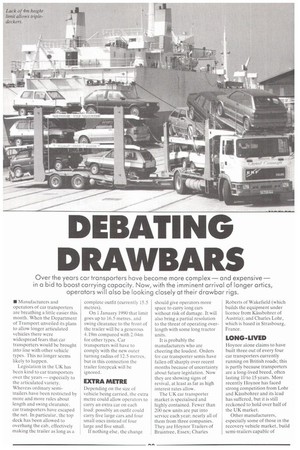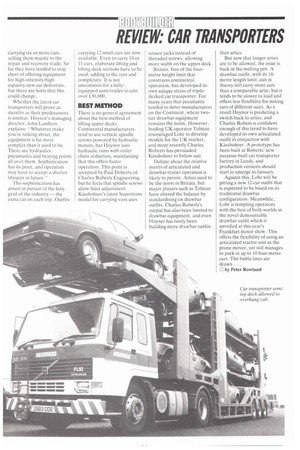DEBATING DRAWBARS
Page 136

Page 137

If you've noticed an error in this article please click here to report it so we can fix it.
Over the years car transporters have become more complex— and expensive — in a bid to boost carrying capacity. Now, with the imminent arrival of longer artics, operators will also be looking closely at their drawbar rigs.
• Manufacturers and operators of car transporters are breathing a little easier this month. When the Department of Transport unveiled its plans to allow longer articulated vehicles there were widespread fears that car transporters would be brought into line with other vehicle types. This no longer seems likely to happen.
Legislation in the UK has been kind to car transporters over the years — especially to the articulated variety. Whereas ordinary semitrailers have been restricted by more and more rules about length and swing clearance, car transporters have escaped the net. In particular, the top deck has been allowed to overhang the cab, effectively making the trailer as long as a complete outfit (currently 15.5 metres).
On 1 January 1990 that limit goes up to 16.5 metres. and swing clearance to the front of the trailer will be a generous 4.19m compared with 2.04m for other types. Car transporters will have to comply with the new outer turning radius of 12.5 metres, but in this connection the trailer forepcak will be ignored,
EXTRA METRE
Depending on the size of vehicle being carried, the extra metre could allow operators to carry an extra car on each load: possibly an outfit could carry five large cars and four small ones instead of four large and five small.
If nothing else, the change should give operators more space to carry long cars without risk of damage. It will also bring a partial resolution to the threat of operating overlength with some long tractor units.
It is probably the manufacturers who are cheering the loudest. Orders for car transporter semis have fallen off sharply over recent months because of uncertainty about future legislation. Now they are showing signs of revival, at least as far as high interest rates allow.
The UK car transporter market is specialised and highly contained. Fewer than 200 new units are put into service each year: nearly all of them from three companies. They are Hoy nor Trailers of Braintree, Essex; Charles Roberts of Wakefield (which builds the equipment under licence from Kassbohrer of Austria); and Charles Lohr,, which is based in Strasbourg. France.
LONG-LIVED
Hoynor alone claims to have built three out of every four car transporters currently running on British roads; this is partly because transporters are a long-lived breed, often lasting 10 to 15 years. More recently Hoynor has faced strong competition from Lohr and Kassbohrer and its lead has suffered, but it is still reckoned to hold over half of the UK market.
Other manufacturers, especially some of those in the recovery vehicle market. build semi-trailers capable of carrying six or more cars. selling them mainly to the repair and recovery trade. So far they have tended to stop short of offering equipment for high-intensity/high capacity new car deliveries. but there are hints that this could change.
Whether the latest car transporters will prove as durable as their predecessors is unclear. iloynor's managing director, John Lambert, explains: "Whatever make you're talking about, the equipment is far more complex than it used to be. There arc hydraulics. pneumatics and bearing points all over them. Sophistication has its price, and operators may have to accept a shorter lifespan in future."
This sophistication has arisen in pursuit of the holy grail of the industry — the extra car on each trip. Outfits carrying 12 small cars are now available. Even to carry 10 or 11 cars, elaborate lifting and tilting deck sections have to be used, adding to the cost and complexity. It is not uncommon for a fullyequipped semi-trailer to cost over f:30,000.
BEST METHOD
There is no general agreement about the best method of lifting upper decks. Continental manufacturers tend to use verticle spindle screws powered by hydraulic motors, but Hoynor uses hydraulic rams with roller chain reduction, maintaining that this offers faster operation. This point is accepted by Paul Doherty of Charles Roberts Engineering, but he feels that spindle screws allow finer adjustment. Kassbohrer's latest Supertrans model for carrying vans uses
scissor jacks instead of threaded screws, allowing more width on the upper deck.
Britain, free of the fourmetre height limit that constrains continental operation, has developed its own unique strain of tripledecked car transporter. For many years that peculiarity tended to deter manufacturers on the Continent, where twotier drawbar equipment remains the norm. However, leading UK operator Tolman encouraged Lohr to develop models for the UK market, and more recently Charles Roberts has persuaded Kassbohrer to follow suit.
Debate about the relative merits of articulated and drawbar-trailer operation is likely to persist. Artics used to be the norm in Britain, but major players such as Tolman have altered the balance by standardising on drawbar outfits. Charles Roberts's output has also been limited to drawbar equipment, and even Hoyner has lately been building more drawbar outfits than artics.
But now that longer artics are to be allowed, the issue is back in the melting pot. A drawbar outfit, with its 18metre length limit, can in theory still carry more cars than a comparable artic; but it tends to be slower to load and offers less flexibility for mixing cars of different sizes. As a result Hoynor is predicting a switch back to ;inks, and Charles Robers is confident enough of this trend to have developed its own articulated outfit in conjuction with Kassbohrer. A prototype has been built at Roberts' new purpose-built car transporter factory in Leeds, and production versions should start to emerge in January.
Against this, Lohr will he pitting a new 12-car outfit that is expected to he based on its traditional drawbar configuration. Meanwhile, Lohr is tempting operators with the best of both worlds in the novel demountable drawbar outfit which it unveiled at this year's Frankfurt motor show. This offers the flexibility of using an articulated tractor unit as the prime mover, yet still manages to pack in up to 10 four-metre cars. The battle lines are drawn . . .
111 by Peter Rowland




































































































































































